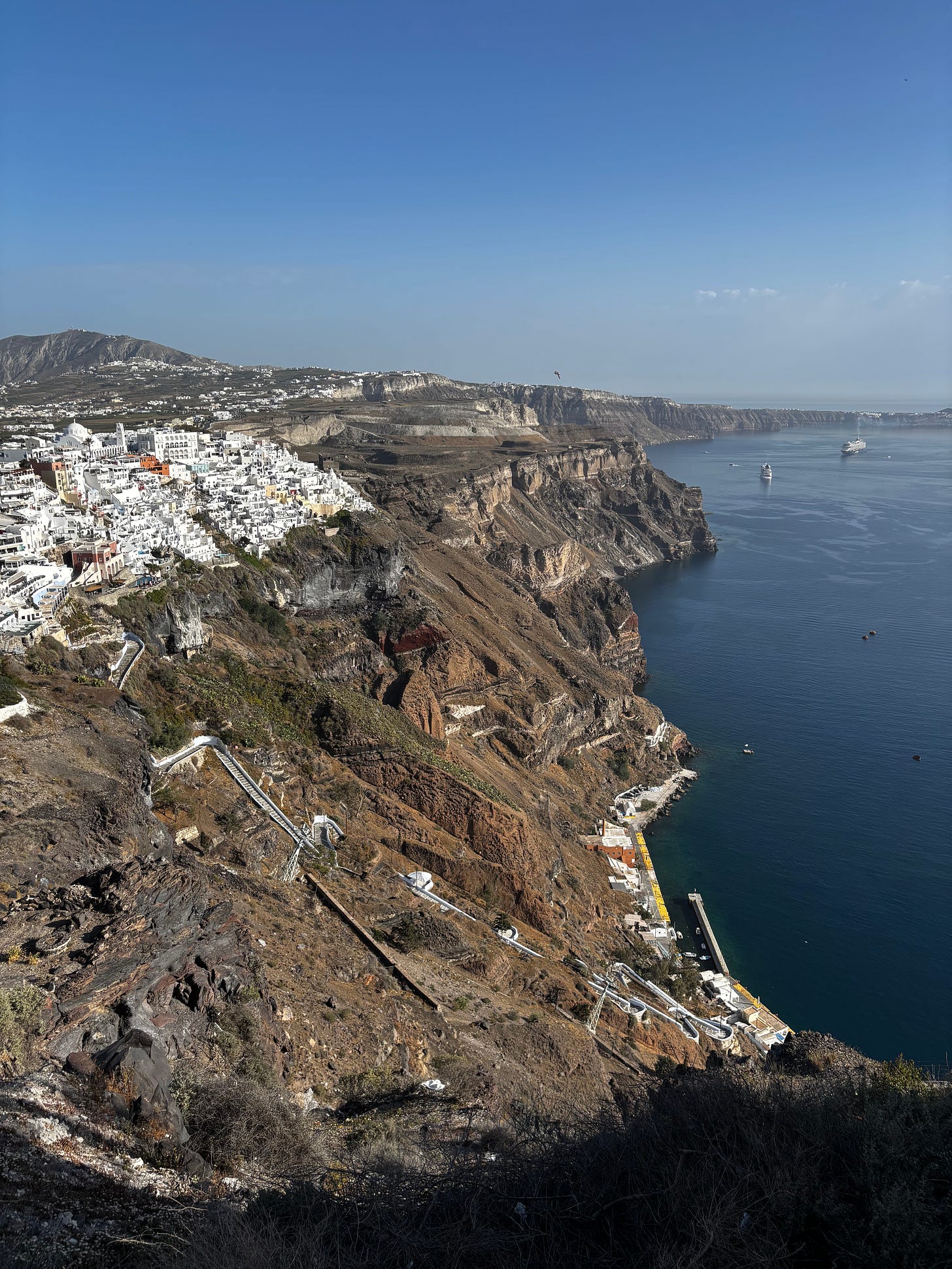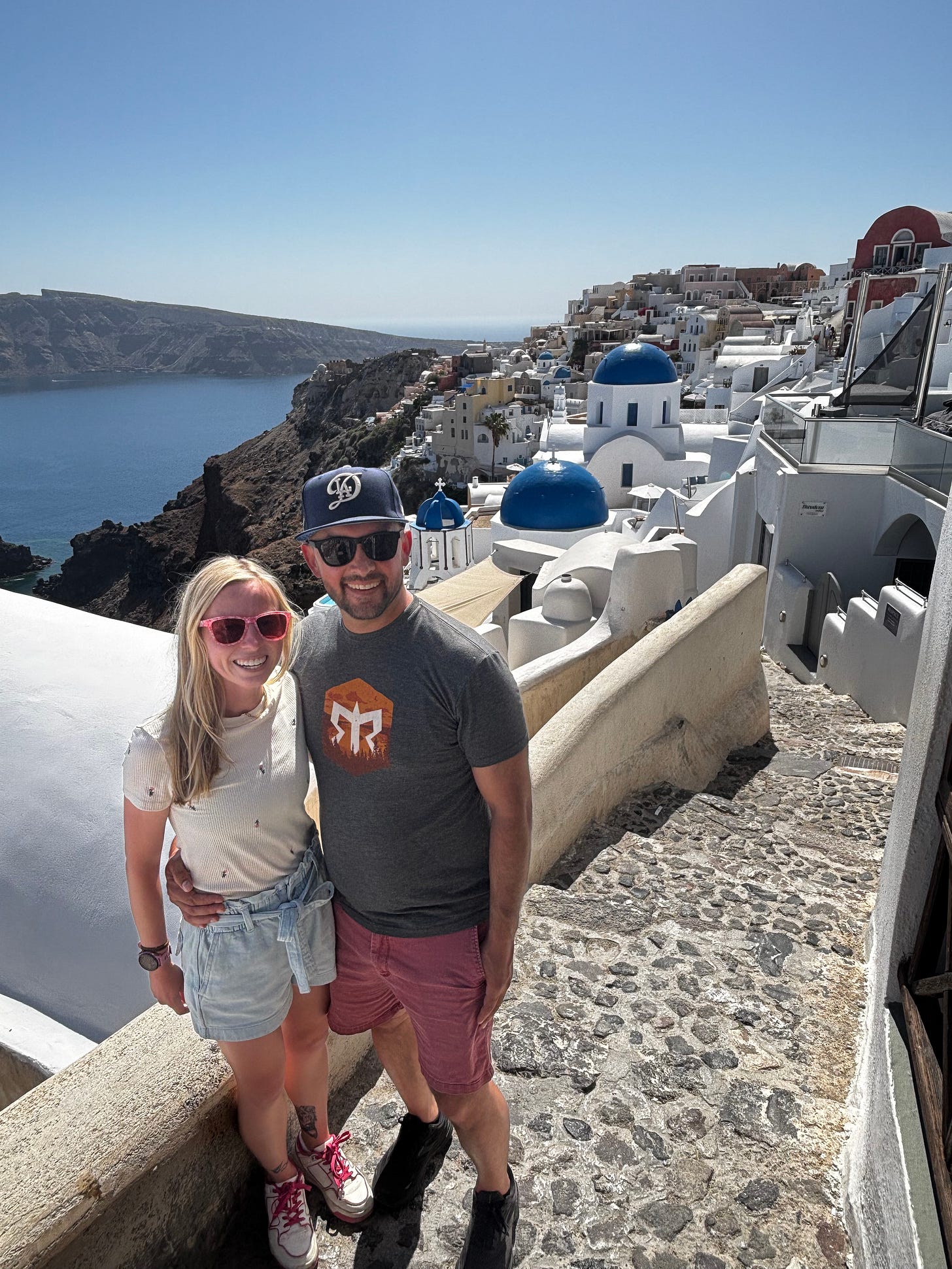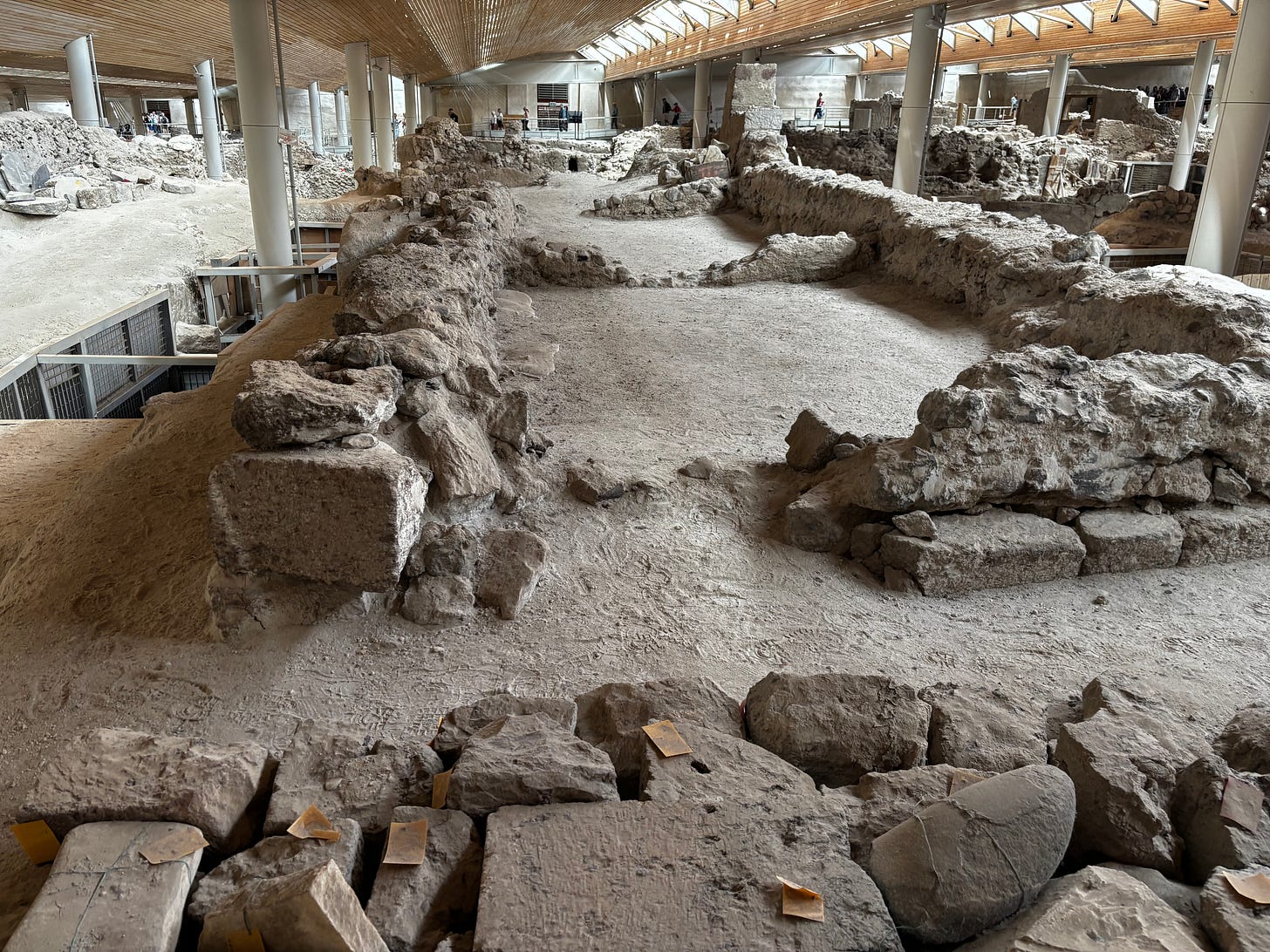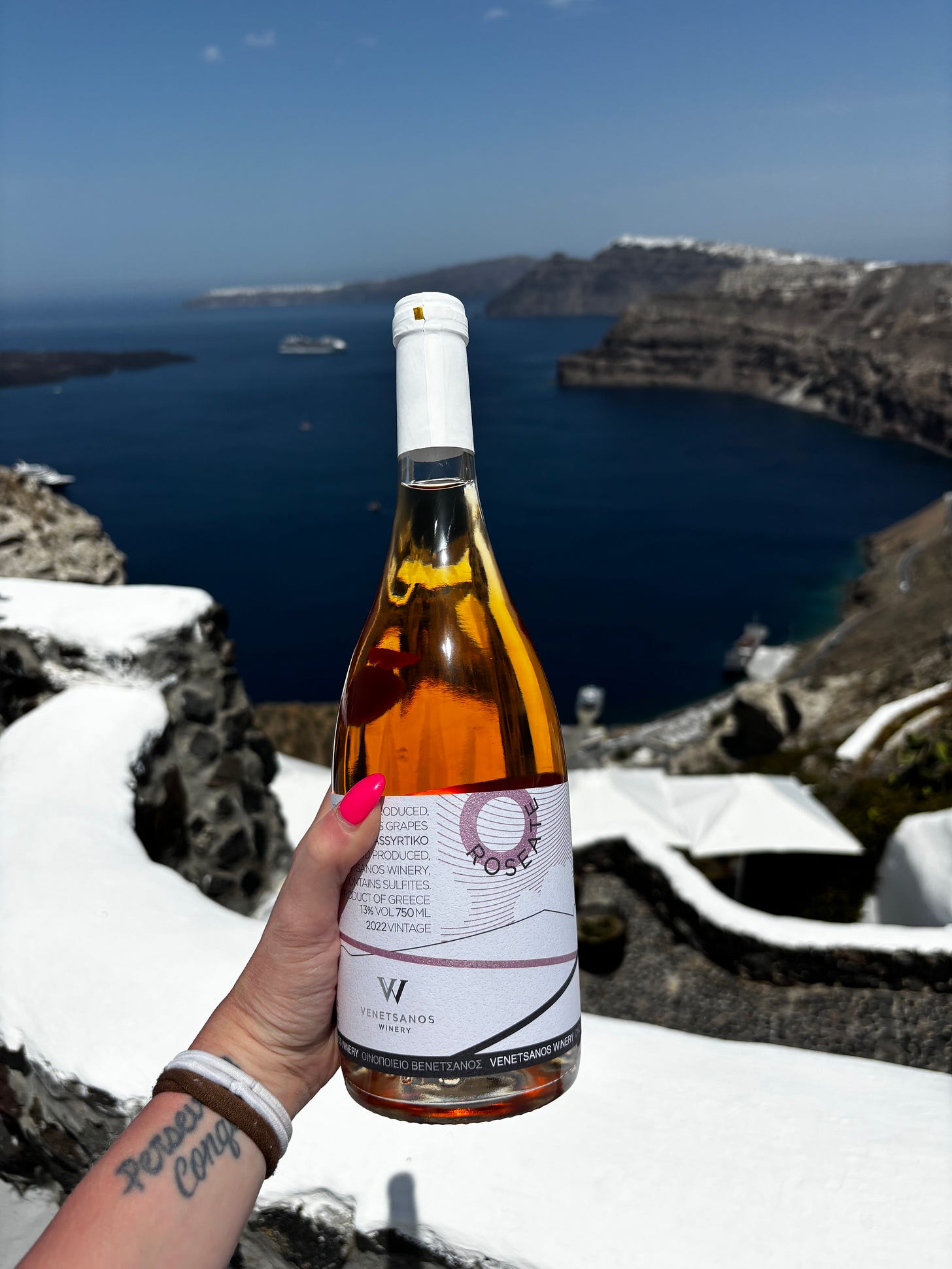A Continuation of Our Latest Travels to Greece
Day 7
Today we were off to a new island, so I got up early to squeeze in one last run in Mykonos. As I ran, I kept admiring the beauty of the coastline. This island is truly special—on one side, you look out over the sparkling sea, and on the other, rolling hills dotted with whitewashed houses nestled into the landscape. It’s such a unique and picturesque contrast.
Along the way, I even passed a few mountain goats "guarding" a house. Those funny little creatures seemed completely at ease, gracefully navigating the steep inclines with the kind of agility that would put most hikers to shame.
By 9:00 a.m., we were headed back to the port—this time to catch another large ferry, which would take us to the final stop of our trip: Santorini.
We boarded the ferry with ease (we were pros at this point) and found our seats. The ride to Santorini takes about two to three hours, as the boat makes a few stops at nearby islands along the way, much like a train. I was impressed by how efficiently the ferry handled unloading and reboarding new passengers at each stop.
When we arrived at the port in Santorini, we were in for our next adventure.
Santorini is part of a volcanic caldera, which means you have to climb incredibly high to reach the portion of the island where the homes are stacked atop one another, clinging to the cliffs. From below, it almost looks like the buildings could topple into the sea at any moment.
The drive up felt like navigating an anthill—our bus zigzagged up narrow switchbacks with hardly enough space for two vehicles to pass. There was no margin for error; one wrong move, and it would be a long fall. We found ourselves genuinely applauding our bus driver for his skill and precision—this is definitely not a drive for beginners.
Perched in the southern Aegean Sea, Santorini (officially known as Thira) is famous for its whitewashed buildings, sapphire-blue domes, and stunning sunsets. But it’s more than just a postcard-perfect destination. The island is the largest in a small circular archipelago formed by one of the most significant volcanic eruptions in recorded history.
Part of the Cyclades island group, Santorini spans roughly 73 square kilometers and is home to just over 15,000 residents. The municipality also includes the inhabited island of Therasia and several smaller, uninhabited islets.
Our tour guide had told us when we left Mykonos that Santorini would be unlike any place we’d ever been—and he was absolutely right.
It almost doesn’t seem real. From above, the caldera is lined with hundreds of homes stacked one on top of the other, forming thriving cliffside villages.
After checking into our next hotel and dropping off our luggage, we set out to explore one of the most famous villages on the island: Oia.
Nestled on the northern edge of Santorini, Oia (pronounced “Ee-ah”) is renowned for its iconic sunsets and distinctive Cycladic architecture. The village sits atop the cliffs, offering panoramic views of the Aegean Sea and the nearby volcanic islets. Its narrow cobblestone streets wind through clusters of whitewashed houses, blue-domed churches, and bright bougainvillea—creating a picture-perfect scene that draws visitors from around the world.
After a brief guided tour, we had time to wander on our own. We stopped to take photos by the famous blue-domed churches and picked up a beautiful piece of artwork to bring home. We always try to find a special piece of art to commemorate each trip—a keepsake that helps preserve the memory for years to come. (More on the story behind this piece in a later post!)
Of course, my husband couldn’t resist grabbing another serving of gelato before we headed back. When in Greece, right?
We ended the day with a lovely group dinner at the hotel—a buffet offering even more delicious Greek cuisine to sample. By the time we turned in for the night, the long day of travel had definitely caught up with us.
Day 8:
I started the morning with a short walk to explore more of our surroundings. Our hotel was near the island’s main city, Fira, and the early morning fog hanging over the buildings and spilling off the edge of the caldera created a scene that was both mysterious and beautiful.
As with many parts of Greece, the island is home to countless wandering cats. I picked up a few companions along my walk. I’ll admit—I'm usually more of a dog person—but Greece was slowly turning me into a cat lover. These agile creatures were so friendly and seemed to move through the world unbothered by any kind of stress. I also noticed that they’re well cared for; food and water are often left out along walkways, ensuring they live their best lives.
After another satisfying breakfast, we joined our tour group and boarded the bus for the day’s cultural highlight: a visit to the prehistoric town of Akrotiri, often referred to as “the Pompeii of Greece.”
Akrotiri was buried in volcanic ash following the massive Thera eruption around the mid-16th century BCE, which preserved its buildings, frescoes, and artifacts in extraordinary condition. To protect and preserve this historical treasure, a modern roofed structure now surrounds the site, allowing visitors to walk through the ancient city under shelter from the elements.
Originally a small fishing village, Akrotiri evolved into a highly sophisticated urban center by the end of the third millennium BCE. Its prime location along major maritime trade routes enabled thriving commerce with Egypt, Crete, and the Near East. The town featured multi-story buildings, paved streets, an advanced drainage system, and colorful frescoes—all signs of a remarkably organized society.
The frescoes, some of the most significant examples of Aegean art, were preserved in their original locations. They offer vivid depictions of daily life, nature, and ceremonial practices. One fascinating detail: no human remains have ever been discovered at Akrotiri, suggesting that its inhabitants evacuated the city before the eruption—an organized escape that spared lives but left their city frozen in time.
It was a fascinating tour and one of those experiences that makes you wonder what life was really like thousands of years ago. I hadn’t known much about Akrotiri before the trip, but I was so glad we made time for it.
After leaving the archaeological site, our next stop was a wine tasting. While driving through Santorini, we’d often seen what looked like low, shrubby plants growing from the island’s distinctive black volcanic soil. These turned out to be grapevines—specially adapted to thrive in the dry climate, absorbing moisture from the humid air rather than from rain or irrigation.
We visited Venetsanos Winery to sample these unique wines. We tasted four varieties, and the group consensus was clear: the rosé and dessert wines were the favorites. It was a relaxing afternoon, and we spent time mingling with the group. At one point, we all began sharing engagement and wedding stories—many couples on the tour had been married over 40 years, and it was heartwarming to hear about their journeys together.
Later in the afternoon, our guide took us to one of Santorini’s iconic black sand beaches: Perissa Black Sand Beach, located a bit farther from the main town. After about a 20-minute drive, we arrived and walked along the beach promenade. The setting felt like something out of a postcard—tropical and surreal.
Although called a "sand" beach, it’s actually made up of tiny black pebbles, which took some getting used to underfoot. We attempted a dip in the ocean but quickly discovered that the seabed was uneven and rocky, and with the high tide, it became difficult (and slightly risky) to fully get in. As a runner, I’m always conscious of staying injury-free, so we opted to wade in carefully and enjoy the scenery from the shore.
Once we’d had our fill of beachside relaxation, we headed to a seaside restaurant for dinner. As with every meal in Greece, it was unhurried and rich with conversation. Greek culture doesn’t rush dinner—it’s seen as sacred time—and honestly, that slower pace felt like a gift compared to the fast-paced dining we’re used to in the U.S.
As the sun set and the evening drew to a close, we headed back to the hotel and off to sleep. Our time in Greece was nearing its end, but we still had a few more days to soak in the beauty and culture.
The final stretch of the trip is just ahead—and as they say, all good things must come to an end.








